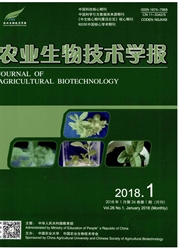

 中文摘要:
中文摘要:
二氢黄酮醇还原酶(dihydroflavonol 4-reductase,DFR)是植物花青素合成过程中的关键酶,催化二氢黄酮醇生成无色花青素。本研究利用花生(Arachis hypogae a L.)未成熟种子cDNA文库,通过大规模EST测序,从花生中克隆了DFR基因的全长cDNA序列。序列分析表明,花生DFR蛋白氨基酸序列与其他植物来源的DFR有很高的同源性。利用花生cDNA芯片和半定量RT-PCR方法对花生DFR基因表达模式的研究发现,DFR基因在果针中表达水平最高,其次是花,在根和叶中有微量表达;不同种皮颜色花生品种的种子中表达差异明显,随种皮颜色的加深,DFR基因表达增强,在中花9号黑色种子中表达量最高。对茎叶紫色花生种质材料的研究表明,在紫色组织中DFR基因表达较强。结果表明DFR表达量与花青素积累量呈正相关,说明DFR催化反应是花青素合成途径的关键步骤。
 英文摘要:
英文摘要:
Dihydroflavonol 4-reductase (DFR) is a key enzyme converting dihydroflavonols to leucoanthocyanidins in the biosynthesis of anthocyanins. EST sequencing was carried out using a cDNA library of peanut(Arachis hypogaea L.) immature seed and full length cDNA of peanut DFR was cloned. Sequence alignment showed that DFR was highly conserved among different plant species. Peanut cDNA microarray and semi-quantitative RT-PCR were used to analysis the expression of DFR in different tissues. Results indicated that the expression level was highest in gynophores and followed by flowers, while the expression in roots and leavies was low. DFR gene expression was also analysed in seeds from different cultivars, which suggested that it expressed higher in cultivars with dark-color seed coat, the expression was the highest in ZH9 seeds with black seed coat. We also analysed the expression level of DFR in a peanut mutation with purple leaves and stems, which demonstrated that DFR was highly expressed in the purple tissues. These results demonstrate that the expression level of DFR gene is positively correlation to the accumulation of anthocyanins, which indicates that DFR catalytic reaction is the key step in the biosynthesis of anthocyanins.
 同期刊论文项目
同期刊论文项目
 同项目期刊论文
同项目期刊论文
 期刊信息
期刊信息
